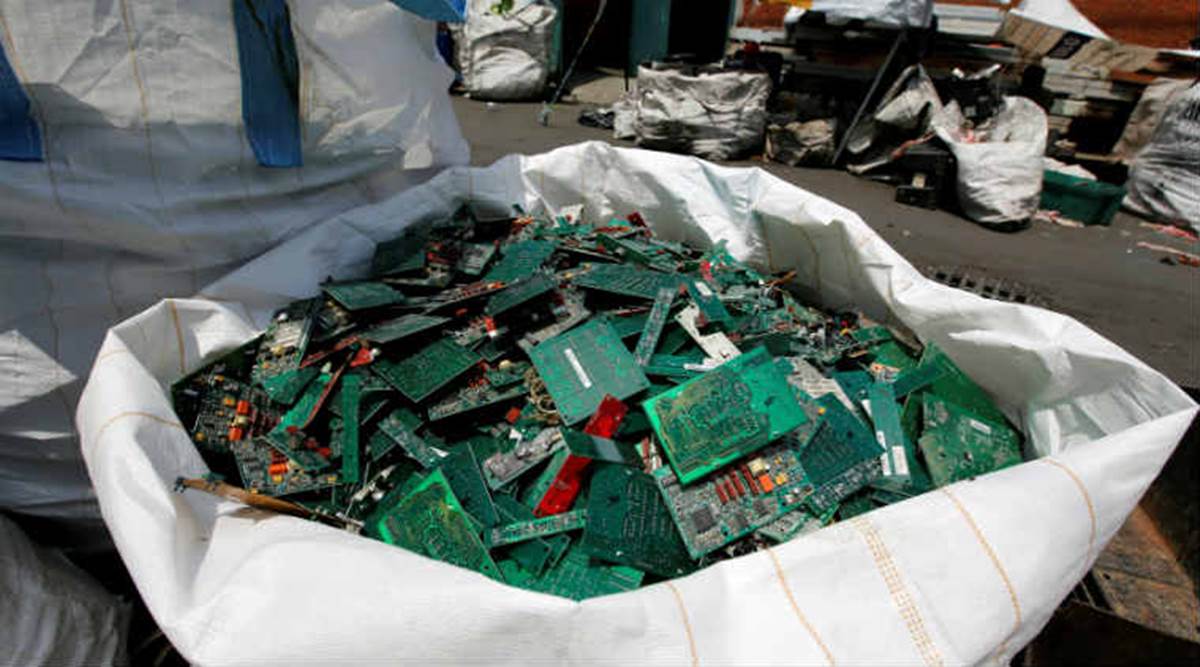 While recycling is one of the sustainable solutions to manage e-waste, adequate emphasis should also be placed on “reducing” and “reusing” before recycling. (File)
While recycling is one of the sustainable solutions to manage e-waste, adequate emphasis should also be placed on “reducing” and “reusing” before recycling. (File)Written by Manika Malhotra
The COVID-19 era has witnessed an exceptional degree of digital transformation in just a few months. Many platforms have enabled this accelerated transformation by providing robust and accessible digital solutions to chat, call and meet seamlessly. This year has witnessed and continues to witness dramatic changes across various sectors, which have a far-reaching impact on how we live, serve, educate and shape our future. The pandemic-induced change in habits, where a striking range of work is done remotely, is likely to persist well beyond the crisis. As a result, a serious and potent challenge of e-waste management and disposal stares us in the face. Although half of the country’s population is online, the offline management of their discarded equipment lacks attention.
In Delhi/NCR, the level of air quality reached the brink of “emergency” in November. Amongst major causal factors such as stubble burning in the neighbouring states, the practice of burning “e-waste” in many unauthorized units also worsened PM 10 and PM 2.5 levels.
In the Union Budget 2020, the finance minister has announced a new scheme to push and escalate domestic manufacturing of electronics and semiconductor units. India is also getting ready to upgrade to the next generation of 5G network by 2021. The amount of electronics that may become obsolete due to incompatibility with the 5G network will add up to a substantial environmental cost.
While recycling is one of the sustainable solutions to manage e-waste, adequate emphasis should also be placed on “reducing” and “reusing” before recycling. A “circular” concept, therefore, aims to reduce e-waste at each step in the lifecycle of electronics. It demands a shift from the traditional “take-make dispose-model” towards closing the loop by switching to a circular economy framework. It is crucial to design electronics with a longer lifespan and be repairable in order to step towards a green recovery. Apple recently made a commendable move of not providing earphones and charger in iPhone boxes to reduce its carbon footprint and reduce “e-waste”. Adapting to a “circular framework” requires conscious reuse of electronics by consumers. It also demands reuse of metals recovered from obsolete electronics as raw materials in future production.
In order to comprehend the “resource” nature of e-waste and its true potential, we must map its reverse logistics chain. Once we trade up our old gadgets for new, where do our gadgets go? The majority is channelised to informal sector workers who have minimal awareness about the adverse consequences of mishandling e-waste. The framework of practices involved in informal recycling of e-waste, such as manual dismantling and incineration, exposes workers to health hazards. If the gadgets aren’t handled properly, they can lead to organ damage, neurological damage and severe illness not only for the waste workers but also the population residing in the vicinity. Incineration of e-waste also discharges lethal gases into the air.
At present, the magnitude of e-waste collected from consumers doesn’t actually enter the circular cycle of electronics; it is instead channelised to a “mafia” of informal “traders”, who have significant financial control in the e-waste market and tend to exploit the cheap labour force available. The real irony is that while “e-waste” policy doesn’t consider the activities of the informal sector as “legal”, the supply of e-waste attracts 5 per cent GST. This has indirectly allowed various informal sector players to trade in e-waste by moving it from one city to another by simply paying the GST to ensure legal compliance. For instance, by paying 5 per cent GST, an informal trader can transport e-waste from other cities to Delhi in a legally compliant manner.
In contrast, there is a lack of legitimate and cost-effective formal collection mechanisms to channelise waste from consumers into the formal segment. In India, the technologies available are meant mainly for recovering and recycling components like glass etc. and the crushed e-waste with precious metals is sent to smelting refineries outside India — to Belgium, Singapore and other countries. India treats less than 1 per cent of its e-waste formally.
Despite policy interventions, a bulk of e-waste still lands up in the hands of the informal sector. Whereas policy highlights the role of formal actors in the e-waste value chain, the demand for the formal services is relatively low and the quality of services offered is ambiguous. Illegal processing of e-waste continues in Delhi and other states, acting as a source of livelihood to thousands of men, women and children. There is a need to sensitise informal sector workers, provide incentives and create opportunities to absorb them in the formal system. This requires a greater amount of attention after the coronavirus downturn.
Monitoring the existing facilities at the regional level assumes critical importance considering the presence of multiple unauthorised repair facilities operating in the localities of Delhi. Many authorised dismantlers have also been selling waste to the informal sector, in complete violation of the law thus making monitoring of e-waste management challenging. Technological developments, increasing dependence of people on electronic products and the pandemic-induced digital transformation are some of the contributing factors towards the “sustained” e-waste crisis. It is high time that the current “consumption and disposal” system of electronic gadgets is also “reset” to break the vicious cycle resulting in unbridled accumulation of e-waste in the environment. E-waste management in the emerging “new-normal” set-up must ensure accountability, transparency and supply-chain justice. The need of the hour is to reboot and reinforce the collection and recycling system.
(The writer is a researcher at Policy Perspectives Foundation)